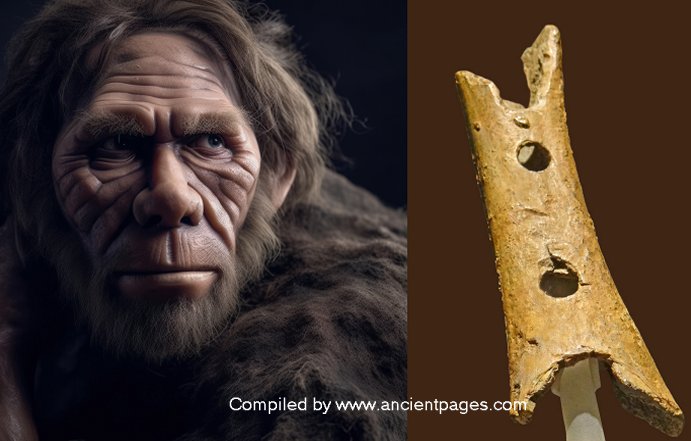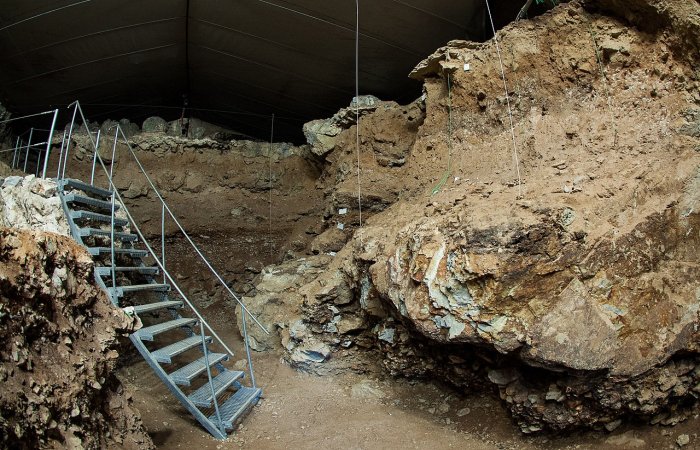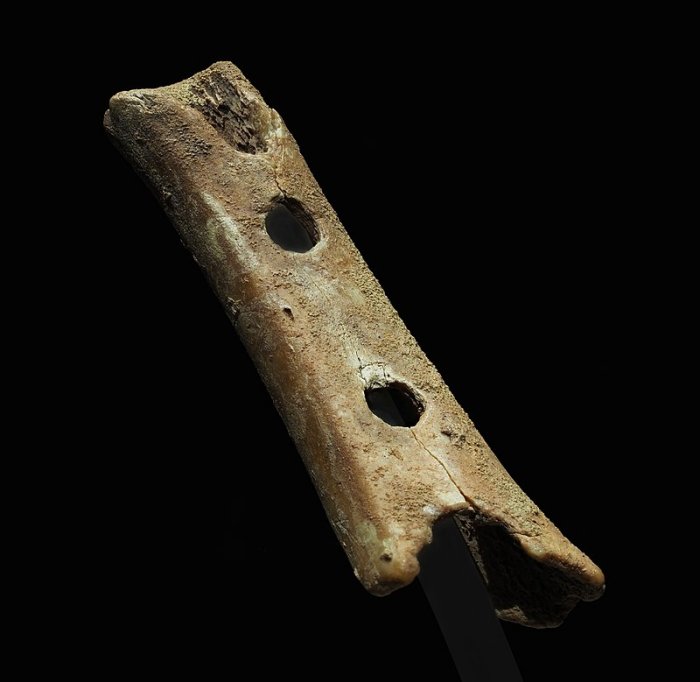Jan Bartek – AncientPages.com – Our long-gone ancestors, the Neanderthals, did not differ that much from modern humans. Like us, the Neanderthals were curious about the world around them and explored new areas. They enjoyed and collected beautiful objects. They deliberately collected perforated shells to string them together like beads 120,000 years ago. Sometimes, they used shells as body ornaments, and there is evidence Neanderthals were the world’s first artists.

One cannot and should not undermine Neandethal’s intelligence and skills. They were by no means primitive. In fact, there is scientific evidence our ancestors appreciated beauty, and it seems clear they even enjoyed music.
The world’s oldest known musical instrument is said to be a bone flute created by Neanderthals 50,000 – 60,000 years ago.
The flute was found by archaeologists who explored the cave of Divje Babe in Slovenia back in 1995. The archeology team from the Insтιтute of Archaeology of the Research Centre of the Slovenian Academy of Sciences and Arts led by Ivan Turk found the carved bone flute beside a hearth once used by Neanderthals.
The prehistoric musical instrument is “made from the thigh bone of a young cave bear into which the Neanderthal drilled three holes and made a sharpened rim for the mouthpiece using tools made of bone and stone.” 1
The 11.4 cm long object is at least 10,000 years older than the earliest Aurignacian wind instruments discovered in the German caves Hohle Fels, Geißenklösterle, and Vogelherd. Studies of the Divje Babe flute showed the Neanderthals managed to produce a more advanced musical instrument than all other previously known Palaeolithic flutes in Europe made from bird bones by the first anatomically modern humans.
The Divje Babe ‘ flute has been met with skepticism by some scientists who argued Neanderthals were not spiritual beings capable of sublime artistic creations such as music. In addition, skeptics questioned whether holes in the flute were of artificial origin.
Some argued a carnivore had made the holed. This argument was based on the observation that the edge of the holes on the Neanderthal flute differed from those on Upper Palaeolithic flutes and showed no conventional signs of human manufacture (i.e., cut marks). In addition, both ends of the Neanderthal flute showed damage typical of gnawing by carnivores. 2

Excavations of the Divje Babe cave where the Neanderthal flute was found. Credit: Thilo Parg – CC BY-SA 3.0
Determined to learn the truth about the Divje Babe flute, researchers conducted a computed tomography analysis. The study results showed stone tools could have made the flute’s holes. The debate about whether the Divje Babe flute was a work of Neanderthals or not continued for a while. Some archaeologists suggested the flute had been made by Cro-Magnon man, while others were convinced animals had altered the object. Could animals bite two holes at once?
Scientists tested the possibility and discovered there were not any known animals that could bite two or more such holes at once.

The Neanderthal flute is displayed in the National Museum of Slovenia. Credit: Petar Miloševic – CC BY-SA 4.0
Today, most scientists subscribe to the theory the Divje Babe flute is an intentionally made musical instrument. The Neanderthal flute has been studied by several musical researchers. In its preserved state, the find is unsuitable for playing music, as are none of the other discovered Upper Palaeolithic wind instruments, traditionally called flutes or pipes. However, a reconstruction of the Divje Babe flute has a capability of 3½ octaves and all contemporary music genres can be played on it.
The Divje Babe flute is on public display in the National Museum of Slovenia in Ljubljana. it may be a small object, but the Divje babe flute is a big discovery that offers evidence Neanderthals did appreciate music.
Written by Jan Bartek – AncientPages.com Staff Writer
Copyright © AncientPages.com All rights reserved. This material may not be published, broadcast, rewritten or redistributed in whole or part without the express written permission of AncientPages.com
Expand for references
- Divje Babe – The Neanderthal Flute
- Turk, Matija; Turk, Ivan; Dimkaroski, Ljuben; Blackwell, Bonnie A.B.; Horusitzky, François Zoltán; Otte, Marcel; Bastiani, Giuliano; Korat, Lidija (2018). “The Mousterian Musical Instrument from the Divje babe I cave (Slovenia): Arguments on the Material Evidence for Neanderthal Musical Behaviour”. L’Anthropologie. 122 (4): 679–706. doi:10.1016/j.anthro.2018.10.001
- Turk, I., Bastiani, G., Blackwell, B.A.B., Horusitzky, F.Z. 2003, Putative Mousterian flute from Divje babe I (Slovenia): Pseudoartefact or true flute, or who made the holes? Arheološki vestnik 54, 67–72.





